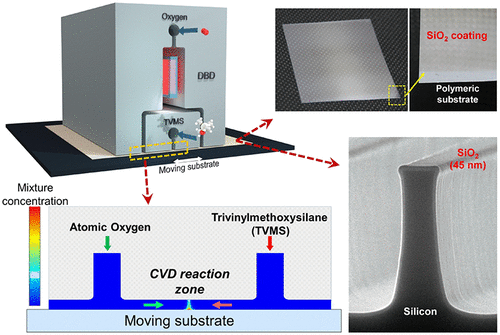
-
- au
Ici vous trouverez le papier de l'équipe SALD
"SiO2 constitutes one of the most widely used dielectric materials in the microelectronics, packaging, and optical industries. Therefore, the development of new processes to deposit SiO2 at low temperature and in an affordable and scalable way are desirable. In this work, we present a low-temperature, open-air process based on spatial atomic layer deposition (SALD) that yields high purity SiO2 films at temperatures down to room temperature. The films were obtained by operating our SALD system in CVD mode (i.e., allowing precursor crosstalk), using an oxygen plasma in combination with trivinylmethoxysilane (TVMS). TVMS is an appealing precursor since it is highly volatile, is affordable, and does not contain halogen elements, thus being very suitable for application in atmospheric-pressure spatial deposition systems. Conversely, water, oxygen, hydrogen peroxide, or ozone did not show any reactivity with TVMS at temperatures up to 260 °C. Thus, when operating our system in ALD mode, no film could be obtained due to the lack of reactivity of the precursor with OH* surface groups. 3D printing was employed to fabricate custom heads integrating both the precursor injector and the atmospheric plasma generator. Our results show that conformal SiO2 thin films can be deposited by our atmospheric plasma-enhanced spatial chemical vapor deposition (APE-SCVD) approach at low temperatures (RT–180 °C) on different substrates, including silicon wafers, microglass slides, or even polymeric substrates with a high growth rate up to 2–5 nm/min. The deposition rate increased when increasing the power applied to the plasma reactor but decreased when increasing the deposition temperature due to the faster decay of the metastable oxygen radical species. FTIR results showed no differences for films deposited with different plasma powers. Conversely, temperature had an effect on the ratio between the AS1 and the AS2 bands. Even though the deposition of SiO2 was carried out at low temperatures in the open air using a metalorganic precursor, no contamination from SiNx or SiCx was observed by FTIR and XPS measurements. Our results open the door to the low-temperature, fast printing of Si-based devices."


